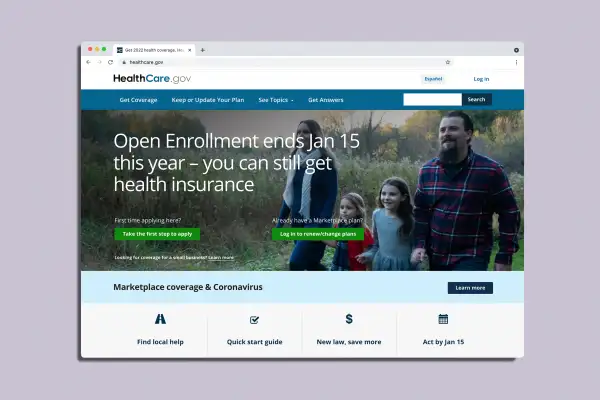The Deadline to Enroll in Obamacare for 2022 Is Almost Here

Open enrollment ends Saturday for health plans under the Affordable Care Act (ACA). It's not too late to check out the low-cost Obamacare options for this year and either switch your existing coverage or sign up for a plan for the first time.
If you buy individual or family health insurance through healthcare.gov or your state’s marketplace, you have until Jan. 15 to finalize your coverage for 2022. Those who do nothing are automatically re-enrolled into their current plan.
But this isn't the year to sit out open enrollment, experts say. The American Rescue Plan that became law last March included a broad expansion of premium subsidies that makes coverage more affordable for all consumers, including those whose higher incomes in the past disqualified them from any assistance.
If you wrote off coverage as out of reach, it’s time to revisit your options. “Even if you've checked in the past, you really owe it to yourself to look for 2022,” says Louise Norris, a licensed broker and health policy analyst for healthinsurance.org. "Coverage is so much more affordable."
Many consumers have already gotten the message: On Monday, the Centers for Medicare & Medicaid Services announced a 21% increase in plan selections through Dec. 15 compared to last year’s open enrollment in the 33 states using the healthcare.gov platform. If you think you might need help choosing a plan, find market-certified assistance here.
When is Obamacare open enrollment for 2022?
Open enrollment for the ACA, also known as “Obamacare,” began Nov. 1, 2021 and runs through Jan. 15 in most states. This is the last opportunity to enroll in a health insurance plan for 2022 unless you qualify for a special enrollment period. The deadline is generally midnight in your local time zone, but try not to cut it that close in case you encounter any difficulties.
About 17 states and Washington, D.C., operate their own health insurance marketplaces, and some of them have different deadlines. For example, California and New York are two states with Jan. 31 deadlines, while Idaho's deadline already passed. See the full list here.
If you enroll by Jan. 15, 2022, your coverage will begin Feb. 1.
Where is the health insurance marketplace?
Most states use the federal marketplace at healthcare.gov, and you can buy your policy directly on that site. If your state operates its own marketplace, you can still get there from healthcare.gov: Select your state and the site will provide a link to your state’s health insurance hub.
All of the plans on healthcare.gov and the state-run exchanges are comprehensive plans that must cover essential health benefits such as maternity care, hospitalizations, prescription medications and any pre-existing conditions of the policyholder.
You can buy coverage through a broker as well, and a knowledgeable one can help you compare your many options and decide what's best for you. Just make sure you're clear on the fine print. In addition to selling ACA plans, outside websites may sell plans that are not comprehensive health insurance, such as skimpy short-term plans that are cheaper but often come with a host of exclusions for pre-existing conditions.
How to get affordable health insurance
The American Rescue Plan temporarily removed income caps for premium subsidies, so people whose incomes used to be too high to qualify will be eligible for reduced premiums through 2022. In 2020, eligibility for premium assistance was capped at around $50,000 for an individual and around $86,000 for a family of three, and coverage above those thresholds was generally much more expensive.
The American Rescue Plan increased the number of people eligible for a premium subsidy by 20%, to 21.8 million from 18.1 million, according to an analysis from the Kaiser Family Foundation. People with incomes between 400% and 600% of the federal poverty level, who previously made too much to qualify for subsidies, will save an average of $213 a month, according to the analysis, while those with incomes under 150% of the poverty level will save an average of $33 per month, the analysis found. These lower-income consumers will have access to benchmark "silver-tier" plans for $0 a month.
Four out of five consumers will be able to find health coverage for $10 or less per month thanks to the American Rescue Plan, the U.S. Department of Health & Human Services said in a statement.
While that’s a great deal, it’s important to look beyond the monthly premium cost. Many of the cheapest plans come with the highest deductibles — the amount of money you have to pay out-of-pocket for covered services before your health insurance kicks in. So if you have a health condition that requires regular management, or if you get into a serious accident, you could potentially be on the hook for thousands of dollars. (Many plans do cover some preventive services 100% before you hit the deductible, and low-income consumers qualify for special discounts on deductibles and other out-of-pocket costs.)
Also, if you see regular doctors, make sure they take the plan you’re considering. A good way to do this is to call each doctor and give the billing office the full name of the plan, Norris says. For example, don't just say, "Do you take Aetna?" but instead give the specific name of the plan. Most insurance companies have doctor directories online, but those could be out of date.
More From Money:
22 Ways to Have the Best Money Year of Your Life
How to Get Free At-Home COVID-19 Tests: 5 Key Details About the Government's New Plan

